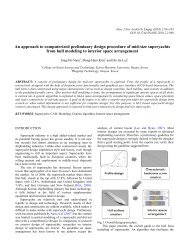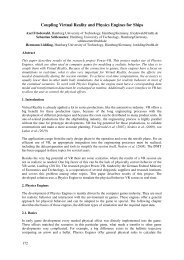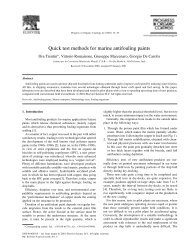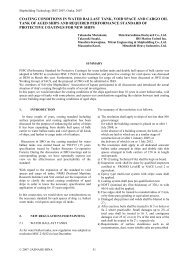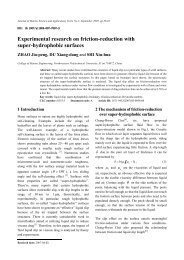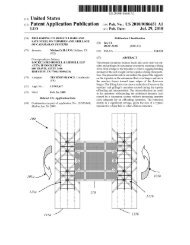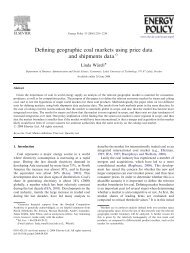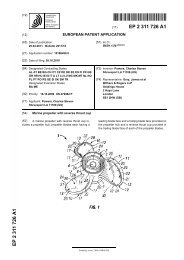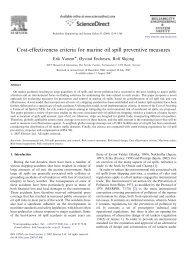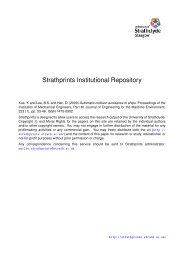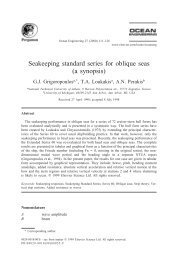Kalman filtering of vessel motions for ocean wave directional ...
Kalman filtering of vessel motions for ocean wave directional ...
Kalman filtering of vessel motions for ocean wave directional ...
You also want an ePaper? Increase the reach of your titles
YUMPU automatically turns print PDFs into web optimized ePapers that Google loves.
<strong>Kalman</strong> <strong>filtering</strong> <strong>of</strong> <strong>vessel</strong> <strong>motions</strong> <strong>for</strong> <strong>ocean</strong> <strong>wave</strong> <strong>directional</strong><br />
spectrum estimation<br />
Ricardo Pascoal, C. Guedes Soares<br />
Centre <strong>for</strong> Marine Technology and Engineering (CENTEC), Technical University <strong>of</strong> Lisbon, Instituto Superior Técnico, Av. Rovisco Pais, 1, 1049-001 Lisboa, Portugal<br />
article info<br />
Article history:<br />
Received 20 May 2008<br />
Accepted 18 January 2009<br />
Available online 31 January 2009<br />
Keywords:<br />
Harmonic detection<br />
<strong>Kalman</strong> <strong>filtering</strong><br />
Spectral estimation<br />
Hydrodynamics<br />
1. Introduction<br />
abstract<br />
Spectral estimation using, as data, the measurements from<br />
inexpensive shipborne sensors has become a topic <strong>of</strong> renewed<br />
interest. Publications have already dealt with several approaches<br />
to solve this estimation problem, which is recognized to be an<br />
important one <strong>for</strong> advisory support, mission planning, guidance<br />
and control systems.<br />
Most <strong>of</strong> the previously published procedures estimate the<br />
<strong>wave</strong> spectral densities by minimizing an error measure built<br />
upon cross-spectral densities. Spectral densities are, in this case,<br />
available from two sources. One source is to estimate them<br />
directly from the data and the second source is to calculate them<br />
using the estimated <strong>wave</strong> spectrum.<br />
Generally, the <strong>for</strong>mulations <strong>for</strong> estimation may be classified as<br />
parametric and non-parametric, depending on whether or not a<br />
parametric <strong>for</strong>mula exists to constrain the spectral shape. Under<br />
these classifications there exist various methods and there are<br />
also several procedures in use to estimate the data cross-spectral<br />
densities from the motion data. These procedures may be<br />
generally classified as based on fast Fourier trans<strong>for</strong>m (FFT) and<br />
Auto-Regressive Moving Average. If the <strong>for</strong>mulation is nonparametric,<br />
constraints on the smoothness <strong>of</strong> the estimate are<br />
applied by invoking prior distributions and Bayesian theory<br />
(Tannuri et al., 2001; Nielsen, 2005; Saito et al., 2000; Iseki and<br />
Ohtsu, 2000) or directly through a functional (Pascoal et al., 2007;<br />
Pascoal and Guedes Soares, 2008). There are also cases without<br />
Corresponding author.<br />
E-mail address: guedess@mar.ist.utl.pt (C. Guedes Soares).<br />
0029-8018/$ - see front matter & 2009 Elsevier Ltd. All rights reserved.<br />
doi:10.1016/j.<strong>ocean</strong>eng.2009.01.013<br />
ARTICLE IN PRESS<br />
Ocean Engineering 36 (2009) 477–488<br />
Contents lists available at ScienceDirect<br />
Ocean Engineering<br />
journal homepage: www.elsevier.com/locate/<strong>ocean</strong>eng<br />
This paper proposes a high-speed iterative procedure <strong>for</strong> estimating the <strong>ocean</strong> <strong>wave</strong> <strong>directional</strong><br />
spectrum from <strong>vessel</strong> motion data. It uses as input data, the measurements from motion sensors that<br />
are commonly available on dynamically positioned <strong>vessel</strong>s and which may easily be installed on any<br />
ship. Because the necessary sensors are relatively inexpensive or may already be installed, it becomes an<br />
ideal solution to provide initial estimates to <strong>of</strong>fline estimation procedures and to give spectral updates<br />
under quickly changing weather conditions. The <strong>Kalman</strong> <strong>filtering</strong> algorithm, <strong>for</strong> iterative harmonic<br />
detection, and frequency domain <strong>vessel</strong> response data are used in the estimation procedure. The results<br />
and conclusions are still based on synthesized data, but very promising.<br />
& 2009 Elsevier Ltd. All rights reserved.<br />
applied smoothing, such as Waals et al. (2002), and which are<br />
closely related to the present work.<br />
In case the non-parametric <strong>for</strong>mulation is used, then spectral<br />
density positiveness constraint must be applied to the spectral<br />
amplitudes. Publications which invoke Bayesian theory, to date,<br />
have en<strong>for</strong>ced the constraint through the trans<strong>for</strong>mation e x , with x<br />
being found from the minimization. Those which use the error<br />
functional en<strong>for</strong>ce this directly as a domain constraint or<br />
alternatively as x 2 . The reason <strong>for</strong> the latter trans<strong>for</strong>mation is to<br />
reduce the size <strong>of</strong> the search domain from the whole real line to<br />
just positive or negative real values.<br />
Presently the computational bottleneck is the error minimization<br />
procedure, which requires iterative methods. Furthermore,<br />
depending on the necessary frequency resolution and crossspectral<br />
estimation procedure, several minutes <strong>of</strong> data may be<br />
required to provide stable results. Though time-varying vector<br />
auto-regression has been proposed in Iseki and Terada (2003) <strong>for</strong><br />
real-time estimation <strong>of</strong> motion cross spectra, the bottleneck<br />
persists since estimation currently takes from 3 to 8 min (Pascoal<br />
et al., 2007; Nielsen, 2006). This is provided that the <strong>vessel</strong> has not<br />
pulled too fast a maneuver, because this may jeopardize the FFT<br />
based estimates. Because, <strong>for</strong> most purposes, a sea state is taken<br />
to be stationary <strong>for</strong> periods <strong>of</strong> 20 min, providing estimates in<br />
3–8 min can be considered real-time with respect to the sea state<br />
parameters. On the other hand, if there is a wish to know about<br />
single <strong>wave</strong> in<strong>for</strong>mation or to update in<strong>for</strong>mation under fast<br />
changing <strong>vessel</strong> heading or weather, then updates need to be<br />
made available at shorter intervals.<br />
The ef<strong>for</strong>t here has been to propose a spectral estimation<br />
procedure that presents some important benefits when compared<br />
to existing ones, the most outstanding ones are with respect to
478<br />
Nomenclature<br />
conc(a, u) concatenates a, u times (used <strong>for</strong> building large<br />
vectors from a stencil vector)<br />
diag u ( ) takes the diagonal from a matrix into vector <strong>for</strong>m and<br />
vice-versa, u superscript indicates number <strong>of</strong> times<br />
the operator is repeated<br />
E[ ] expectation operator<br />
Hjlm complex-valued transfer function <strong>for</strong> frequency j,<br />
heading l and sensor, m<br />
Hs significant <strong>wave</strong> height calculated from zeroeth<br />
I<br />
spectral moment<br />
identity matrix<br />
number <strong>of</strong> headings in the discretization<br />
ny<br />
speed <strong>of</strong> estimation and fusing data from several sources. This<br />
work is a consequence <strong>of</strong> the objectives that have been defined in<br />
a previous work Pascoal et al. (2007), to further study the zero<br />
speed case and produce a faster spectral estimator. In the previous<br />
work the reduction <strong>of</strong> computational time has been achieved<br />
mostly at the cost <strong>of</strong> eliminating the frequency smoothing<br />
constraint. Here this is taken to further extent and a prototype,<br />
high speed, <strong>Kalman</strong> filter-based <strong>wave</strong> spectral estimator is<br />
proposed.<br />
The procedure may be termed faster than real-time because it<br />
can provide many spectral estimates be<strong>for</strong>e sea state stationarity<br />
ceases to be a good hypothesis. An update is available once every<br />
five seconds on a 2.4 GHz Dual Core processor running National<br />
Instruments s LabVIEW Real-Time engine. In this setup, the<br />
<strong>for</strong>mulation is non-parametric and a major difference with respect<br />
to all other existing <strong>for</strong>mulations is that cross-spectral calculations<br />
are not per<strong>for</strong>med and the <strong>wave</strong> amplitudes are estimated<br />
directly.<br />
Currently no frequency or <strong>directional</strong> smoothing constraints<br />
exist, but since they can be cast into linear <strong>for</strong>m through use <strong>of</strong><br />
finite differences, it is possible that the same filter may be used at<br />
the cost <strong>of</strong> increased CPU time. The presented <strong>for</strong>mulation is <strong>for</strong><br />
zero speed <strong>of</strong> advance. Since sensors perceive the encounter<br />
frequency, <strong>for</strong> a given value <strong>of</strong> speed <strong>of</strong> advance the equations<br />
must be adapted in order to take this frequency shift into account.<br />
This is not considered in the scope <strong>of</strong> this paper and though it may<br />
appear simple, in practice, as presented in Nielsen (2007), it may<br />
actually turn out to be a very difficult task.<br />
The results with synthesized data are very promising; however,<br />
more research is needed to verify and improve the present<br />
proposal, including comparisons with model test data and field<br />
data.<br />
Previously existing proposals <strong>of</strong> spectral estimation procedures<br />
which use <strong>vessel</strong> motion records are not intended to take into<br />
account the merging <strong>of</strong> data from additional sources, such as<br />
available radar spectral estimates or other sensor data. The<br />
procedures based on Bayesian models were up to now the ones<br />
closest to providing such capability, because the probabilistic<br />
setting enables designers to specify measures <strong>of</strong> trust and<br />
variability along with rules to adapt the initial estimates.<br />
The <strong>Kalman</strong> filter framework lends itself to the possibility <strong>of</strong><br />
including data from many sources and it may be found to improve<br />
the estimation capabilities at hand.<br />
2. Formulation<br />
Spectral estimation has been per<strong>for</strong>med using <strong>Kalman</strong> filter on<br />
a rotating reference frame. This type <strong>of</strong> reference frame and<br />
ARTICLE IN PRESS<br />
R. Pascoal, C. Guedes Soares / Ocean Engineering 36 (2009) 477–488<br />
nf nr<br />
rjk Tp<br />
number <strong>of</strong> harmonics to estimate<br />
number <strong>of</strong> measured responses<br />
measurement from jth sensor at instant k<br />
spectral peak period<br />
X0 superscript as written indicates transpose<br />
X states, in this case the real and imaginary parts <strong>of</strong><br />
<strong>wave</strong> amplitude<br />
dtt Kronecker delta<br />
xk state white noise vector at the kth instant<br />
Xt state noise covariance matrix<br />
yk measurement noise vector at the kth instant<br />
Yt measurement noise covariance matrix<br />
¯y<br />
P<br />
t<br />
mean direction input to the spreading function<br />
estimation error covariance matrix<br />
<strong>filtering</strong> is used to improve harmonic suppression in electrical<br />
networks, through active circuit designs (Liu, 1998; Rechka et al.,<br />
2003). In order to import these procedures to <strong>wave</strong> spectral<br />
estimation using <strong>vessel</strong> <strong>motions</strong>, the <strong>vessel</strong>’s hydrodynamics have<br />
to be considered and the measurement equations augmented<br />
accordingly.<br />
Knowledge about the frequency domain <strong>vessel</strong> responses is<br />
assumed here, as in all prior publications, to be the most accurate<br />
which can be made available in the <strong>for</strong>m <strong>of</strong> first-order transfer<br />
functions.<br />
The incident <strong>wave</strong>s’ in phase and quadrature components are<br />
the state variables and thus there will be intrinsic in<strong>for</strong>mation<br />
about the phase angles. For each frequency there exist ny 2<br />
states. The hypothesis is that the states have constant or very<br />
slowly varying values when compared to the filter dynamics, and<br />
thus the transition matrix is identity. Consequently (e.g. Liu, 1998;<br />
Rechka et al., 2003), the state equation is<br />
Xkþ1 ¼ Xk þ xk, (1)<br />
i.e. the state at the next time instant, Xk+1, is the same as the<br />
present (very slow variation), Xk, except possibly <strong>for</strong> some<br />
variation due to the state noise xk. The measurement equation,<br />
<strong>for</strong> each sensor, m, is supposed to model what happens at the<br />
available sensors and is <strong>of</strong> the <strong>for</strong>m (Liu, 1998; Rechka et al., 2003)<br />
rmk ¼ Cmk Xk þ yk, (2)<br />
where rmk is an available response at the kth time instant, Cmk<br />
the measurement matrix <strong>for</strong> the mth sensor and yk the measurement<br />
noise. The measurement matrix is responsible <strong>for</strong> taking<br />
the states and producing a response (output) that is to be<br />
compared with one which is available <strong>for</strong> measurement, while<br />
the measurement noise corresponds to the sensor’s limited<br />
capabilities.<br />
This <strong>for</strong>mulation is possible because a response can be<br />
approximated by using a finite number <strong>of</strong> harmonics, each <strong>of</strong><br />
which has amplitude determined from the complex <strong>wave</strong><br />
amplitude and adequate transfer function. Any <strong>of</strong> the responses<br />
may be obtained from the Fourier representation<br />
r ¼ Re Xn f Xn y<br />
Hjm ðX2j 1;m þ ffiffiffiffiffiffiffi p<br />
1X2j;mÞðcosðojtÞþ<br />
ffiffiffiffiffiffiffi<br />
0<br />
1<br />
p<br />
@<br />
1 sinðojtÞÞA,<br />
j¼1 m¼1<br />
which, after collecting states, becomes<br />
r ¼ Xn f<br />
Xn y<br />
ðReðHjmÞ cosðotÞ ImðHjmÞ sinðotÞÞ X2j 1;m<br />
j¼1 m¼1<br />
X n f<br />
Xn y<br />
ðImðHjmÞ cosðotÞþReðHjmÞ sinðotÞÞ X2j;m. (3)<br />
j¼1 m¼1
The Re(Hjm) stands <strong>for</strong> real part <strong>of</strong> the transfer function from<br />
<strong>wave</strong> to the desired response, indexed <strong>for</strong> each frequency and<br />
direction.<br />
The summation in Eq. (3) can be conveniently cast into an<br />
augmented matrix vector product. The matrix will be the timevarying<br />
measurement matrix <strong>for</strong> discrete time and all the states<br />
are cast into a single vector. The matrix is understood to be one<br />
line <strong>for</strong> each sensor, containing all frequencies and headings. This<br />
matrix has dimension nr by ny 2 nf.<br />
Because the measurement matrix includes the <strong>vessel</strong> response<br />
functions, it is particular to the proposed procedure. In Eq. (4), a<br />
part <strong>of</strong> this matrix is shown <strong>for</strong> the jth frequency, kth time instant,<br />
lth response and mth direction, respectively. To build the full<br />
matrix, these submatrices have to be concatenated, leaving k as<br />
the only free index.<br />
C jklm ¼ ReðH jlmÞ cosðo jkTÞ ImðH jlmÞ sinðo jkTÞ<br />
ImðH jlmÞ cosðo jkTÞ ReðH jlmÞ sinðo jkTÞ 0 . (4)<br />
Any errors in the hydrodynamics, unmodeled dynamics and<br />
actual sensor noises have been collected into the measurement<br />
noise term. This term should posses the properties <strong>of</strong> being<br />
Gaussian, zero mean white noise and <strong>of</strong> being uncorrelated with<br />
the state noise. Because <strong>of</strong> the complexity <strong>of</strong> the real <strong>ocean</strong> and<br />
<strong>vessel</strong> responses, such assumptions are hardly possible to verify<br />
be<strong>for</strong>ehand and only a real application can point out if there will<br />
be additional problems to solve.<br />
It is very difficult in this case, if not impossible, to determine<br />
be<strong>for</strong>ehand the ideal size <strong>of</strong> the measurement vector. This<br />
happens because the measurement matrix is time-varying and<br />
there is no control over the excitation imposed by the environment.<br />
One certain thing is that, due to kinematic constraints, the<br />
number <strong>of</strong> independent variables that can be measured is much<br />
less than the number <strong>of</strong> states to be estimated. Thus, if one does<br />
not take adequate action, this leads to singular or badly<br />
conditioned observability matrix, in which case the state<br />
estimates will either fail to be determined or will be very erratic<br />
and without physical meaning. The ability to determine correct<br />
transfer functions has an influence on this as well (e.g. Nielsen,<br />
2007) and some are more sensitive to modeling error than others.<br />
In order to stabilize the state estimates, and increase the rank<br />
<strong>of</strong> the observability matrix, the measurement equation <strong>for</strong> a given<br />
instant is built upon measurements <strong>of</strong> the current time step and<br />
additional lagged measurements. The number <strong>of</strong> time instants to<br />
consider depends on the number <strong>of</strong> headings and frequencies<br />
under estimation, and should be tuned, in the field, <strong>for</strong> a particular<br />
<strong>vessel</strong> and sensor locations.<br />
The covariance matrices are conventional and written as E[xt,<br />
xt] ¼ Xtdtt <strong>for</strong> the state noise, E[yt, yt] ¼ Ytdtt <strong>for</strong> the measurement<br />
noise, and E[Xˆ t Xt, (Xˆ t Xt) 0 ] ¼ P t <strong>for</strong> the state error. The<br />
capital Greek letters stand <strong>for</strong> a matrix and dtt <strong>for</strong> the Kronecker<br />
delta. The delta being zero unless subscripts are equal, in which<br />
Table 1<br />
Simulated sea states and their identification <strong>for</strong> further reference.<br />
ARTICLE IN PRESS<br />
R. Pascoal, C. Guedes Soares / Ocean Engineering 36 (2009) 477–488 479<br />
case it becomes unity. These matrices will include a minus sign<br />
superscript, as in P t , whenever they belong to the prediction<br />
cycle, i.e. when only prior in<strong>for</strong>mation is available.<br />
The standard prediction and update cycles are then written as<br />
(e.g. Liu, 1998; Rechka et al., 2003; Ding et al., 2006)<br />
K k ¼ S k C 0 kðC kS k C 0 k þ YÞ 1 , (5)<br />
^X k ¼ ^ X k þ K kðr k C k ^ Xk Þ, (6)<br />
S k ¼ðI K kC kÞS k ðI K kC kÞ 0 þ KYK 0 , (7)<br />
^X kþ1 ¼ ^ X k, (8)<br />
S kþ1 ¼ S k þ X. (9)<br />
The circumflex, as in Xˆ, stands <strong>for</strong> estimated values. K k is the<br />
filter gain and all variables have been defined in the preceding<br />
text. This gain is responsible <strong>for</strong> weighing the estimation errors<br />
into the new state estimates and, in an idealized situation, the<br />
above procedure is optimal with respect to any well posed<br />
optimality criterion (e.g. Tse and Athans, 1967)<br />
These standard <strong>Kalman</strong> filter equations have been tested. It<br />
was found, however, that they do not suit the present application.<br />
They assume good knowledge <strong>of</strong> the process and that<br />
steady state is reached after some time (the filter drops <strong>of</strong>f<br />
and ceases to per<strong>for</strong>m), but neither is the process completely<br />
known nor steady state guaranteed due to changes in <strong>vessel</strong><br />
heading and sea state. Some type <strong>of</strong> adaptive capability has to be<br />
considered.<br />
Changing the filter gain in a sensible manner is the key to be<br />
optimized. A way to change the filter gains is by updating the<br />
measurement noise covariance matrix. Alternatively the state<br />
noise covariance may be changed, or even both. These options and<br />
the way to go about changing, or adapting, the estimates appear in<br />
several publications (e.g. Liu, 1998; Ding et al., 2006).<br />
The option chosen here has been to estimate the measurement<br />
noise covariance through the use <strong>of</strong> ensemble averages. Although<br />
other options were tested it is probably better, as a first step, to<br />
change only one <strong>of</strong> the matrices and that this matrix be the<br />
measurement noise. The reason <strong>for</strong> this is that the solution to this<br />
Table 2<br />
Added noise standard deviations.<br />
Sea state # Hs swell (m) Hs sea (m) Tp swell (s) Tp sea (s) ¯y swell (deg.) ¯y sea (deg.)<br />
1 5 0 15 – 45 –<br />
2 5 0 15 – 90 –<br />
3 5 0 15 – 180 –<br />
4 5 2 15 10 180 45<br />
5 0 2 – 10 – 45<br />
6 0 2 – 7 – 45<br />
7 0 2 – 7 – 180<br />
x¨ 2 CG<br />
x¨ 3 CG<br />
x 4 x 5 x 6 x¨ 3 bow<br />
s 0.18 0.18 0.016 0.016 0.016 0.18 0.18<br />
x¨ 3 stbd
480<br />
problem is constant at steady state. Additionally, to reduce some<br />
high-frequency behavior presented by the estimates, state<br />
averages have been established between three time instants.<br />
Possibly this <strong>filtering</strong> may also be introduced through an<br />
augmented <strong>Kalman</strong> filter. The ensemble <strong>for</strong> covariance estimation<br />
is composed <strong>of</strong> data from twenty time instants.<br />
Notice that, because instability was arising if all values were<br />
considered, only the diagonal terms, i.e. auto-correlation, have<br />
been kept. The main reason <strong>for</strong> instability <strong>of</strong> the state estimates<br />
during the adaptive stage was found to originate at the<br />
measurement covariance update. Stability <strong>of</strong> correlation estimates<br />
largely depends on the size <strong>of</strong> the estimation window, large<br />
windows being best but at conflict with the real-time requirement<br />
(e.g. Ding et al., 2006), and it was found that cross-correlation<br />
estimates were very unstable whilst auto-correlation presented a<br />
nice behavior.<br />
By eliminating the <strong>of</strong>f-diagonal terms, the filter is in<strong>for</strong>med<br />
that measurement noise is not correlated. It is hard to say if this<br />
will hold in practice, but at this point, due to problem complexity,<br />
the heuristic approach was chosen. The revised part <strong>of</strong> the<br />
<strong>for</strong>mulation is as follows:<br />
^X kþ1 ¼ 1=3 ð^ Xk þ ^ Xk 1 þ ^ Xk 2Þ (10)<br />
Generated Spectral Contours, θ m = 45 45°<br />
N<br />
S<br />
0.3Hz<br />
0.2Hz<br />
0.1Hz<br />
ARTICLE IN PRESS<br />
W E<br />
Generated<br />
Hs = 5m; 0m<br />
Tp = 15s; 10s<br />
R. Pascoal, C. Guedes Soares / Ocean Engineering 36 (2009) 477–488<br />
Estimated Shape at Time instant, t = 100 s<br />
N<br />
0.3Hz<br />
S<br />
0.2Hz<br />
0.1Hz<br />
^Y ¼ diag 2 ðE½r k C k ^ Xk ; ðr k C k ^ Xk Þ 0 ŠÞ þ C kP k C 0 k (11)<br />
3. Sample application<br />
A typical 70-m-long <strong>vessel</strong> is considered. As already mentioned<br />
in most publications addressing the topic (e.g. Tannuri et al., 2001;<br />
Nielsen, 2005; Pascoal et al., 2007), <strong>vessel</strong> length is the single<br />
most important geometric characteristic. It dictates the frequency<br />
up to which head <strong>wave</strong>s may be sensed with good accuracy,<br />
because the zero <strong>of</strong> heave transfer function occurs <strong>for</strong> a frequency<br />
corresponding closely to that <strong>of</strong> a <strong>wave</strong> with length equal to ship<br />
length (Pascoal et al., 2007) (deep water). In this case it is<br />
expected that the frequency at which problems arise is 0.94 rad/s,<br />
corresponding to a period <strong>of</strong> around 7 s.<br />
In this application, measured signals were synthesized through<br />
conventional use <strong>of</strong> FFT, <strong>vessel</strong> transfer functions and JONSWAP<br />
spectral density with cos 2s (same as in Pascoal et al., 2007). The<br />
spectral peak intensification factor, g, and spreading factor, s, have<br />
been kept constant at a value <strong>of</strong> 2.0 (as in Pascoal et al., 2007).<br />
Other parameters are identified in Table 1. In this table, Hs stands<br />
Estimated Shape at Time instant, t = 50 s<br />
N<br />
0.3Hz<br />
S<br />
0.2Hz<br />
0.1Hz<br />
Estimated Shape at Time instant, t = 180 s<br />
N<br />
0.3Hz<br />
S<br />
0.2Hz<br />
0.1Hz<br />
Fig. 1. Generated and evolution <strong>of</strong> estimated contour lines sea state 1.<br />
E
<strong>for</strong> significant <strong>wave</strong> height, Tp is the spectral peak period, ¯y is the<br />
mean direction and the additional terms ‘‘swell’’ and ‘‘sea’’ are<br />
with respect to the corresponding component <strong>of</strong> a single- or a<br />
double-peaked <strong>wave</strong> spectrum (Guedes Soares, 1984). The sea<br />
state # is used in the figure captions.<br />
A total <strong>of</strong> 10 min were generated at a sampling frequency <strong>of</strong><br />
5 Hz and then downsampled to 1 Hz. This allows <strong>for</strong> synthesized<br />
low- and high-frequency content, which will become noise due to<br />
the downsampling. In all presented results, a total <strong>of</strong> seven time<br />
steps are considered at a given instant to build the measured<br />
signals. The time interval between these signals corresponds to a<br />
lag <strong>of</strong> two samples, thus the estimator may only start at time 14 s<br />
from data acquisition startup, at which point the measurement<br />
vector is completely available.<br />
Transfer functions have been calculated using a linear strip<br />
theory (Fathi and H<strong>of</strong>f, 2004) but any source <strong>of</strong> hydrodynamic data<br />
which provides good estimates is applicable. The calculated<br />
transfer functions are aimed at simulating a technically simple<br />
and plausible sensor installation. These are sway and heave<br />
acceleration at the center <strong>of</strong> gravity, roll, pitch and yaw motion,<br />
Generated Spectral Contours, θ m = 90 45°<br />
Generated<br />
Hs = 5m; 0m<br />
Tp = 15s; 10s<br />
N<br />
S<br />
0.1Hz<br />
ARTICLE IN PRESS<br />
R. Pascoal, C. Guedes Soares / Ocean Engineering 36 (2009) 477–488 481<br />
0.3Hz<br />
0.2Hz<br />
Estimated Shape at Time instant, t = 100 s<br />
N<br />
0.3Hz<br />
S<br />
0.2Hz<br />
0.1Hz<br />
vertical acceleration at the bow (35 m from midship) and vertical<br />
acceleration at starboard (5 m from centerline) close to the section<br />
containing the center <strong>of</strong> gravity and at the same vertical position <strong>of</strong><br />
the latter. They are identified, respectively, by the symbols x¨ 2 CG , x¨3 CG ,<br />
x4, x5, x6, x¨ 3 bow and x¨3 stbd , with the dot indicating time derivative. The<br />
transfer functions have been calculated at 301 intervals and<br />
frequencies from 0.1 to 3.6 rad/s at 0.07 rad/s intervals. These<br />
values have been interpolated and extrapolated in order to provide<br />
synthesized signals which do not repeat in the 10 min at the rate <strong>of</strong><br />
5 Hz, but <strong>for</strong> estimation purposes only values between 0.1 and<br />
1.15 rad/s have been used, which means that everything else will<br />
actually become part <strong>of</strong> the induced noise. This results in estimates<br />
at 12 headings and 15 frequencies, totaling 360 state variables.<br />
Measured <strong>motions</strong> from advanced sensor boxes are normally<br />
the result <strong>of</strong> sensor fusion. There are some commercially available<br />
sensor packages, inertial and heading reference units, which<br />
inside have accelerometers, angular rate sensors, flux compass<br />
and GPS, and provide accurate measurements by fusing data<br />
through <strong>Kalman</strong> filters <strong>of</strong> their own. Depending on available<br />
sensors, different measurement equations must be considered. If<br />
Estimated Shape at Time instant, t = 50 s<br />
N<br />
0.3Hz<br />
S<br />
0.2Hz<br />
0.1Hz<br />
Estimated Shape at Time instant, t = 180 s<br />
N<br />
0.3Hz<br />
S<br />
0.2Hz<br />
0.1Hz<br />
Fig. 2. Generated and evolution <strong>of</strong> estimated contour lines sea state 2.
482<br />
the location onboard and type <strong>of</strong> sensors may be specified, then<br />
alternative sensor configurations should be analyzed and the best<br />
one, if any, is chosen. Care should be exercised if prior <strong>filtering</strong> or<br />
processing <strong>of</strong> the signals is needed, <strong>for</strong> instance to band-pass filter<br />
or to integrate acceleration and rate measurements, since these<br />
may jeopardize estimation (Nielsen, 2005).<br />
Since acceleration transfer functions have a slower roll <strong>of</strong>f than<br />
motion, i.e. their amplitudes decay slower at high frequency, a<br />
combination <strong>of</strong> acceleration and displacement measurements is<br />
recommended in order to reduce overestimation at high<br />
frequency and provide good low-frequency estimates. This<br />
suggestion may produce conflict if good motion measurements<br />
are not available, which may be the case <strong>for</strong> heave if GPS readings<br />
are too noisy and present large biases, so, even if at first adding a<br />
sensor may sound beneficial, configurations should be tested in<br />
scenarios closest to reality.<br />
The initial estimates were maintained throughout and are as<br />
follows:<br />
^X 1 ¼ 0 (12)<br />
Generated Spectral Contours, θ m = 180 45°<br />
Generated<br />
Hs = 5m; 0m<br />
Tp = 15s; 10s<br />
N<br />
S<br />
0.3Hz<br />
0.2Hz<br />
0.1Hz<br />
ARTICLE IN PRESS<br />
R. Pascoal, C. Guedes Soares / Ocean Engineering 36 (2009) 477–488<br />
Estimated Shape at Time instant, t = 100 s<br />
N<br />
0.3Hz<br />
S<br />
0.2Hz<br />
0.1Hz<br />
S1 ¼ 2 " #<br />
i i 0<br />
0 1ii 2 3<br />
0:05<br />
6<br />
0:05<br />
7<br />
6 7<br />
6 7<br />
6 0:005 7<br />
6 7<br />
6 7<br />
Y1 ¼ diag conc 6 0:005 7;<br />
6 7<br />
6 0:005 7<br />
6 7<br />
4 0:05 5<br />
0:05<br />
1<br />
7 nr<br />
0 0<br />
11<br />
B B<br />
CC<br />
B B<br />
CC<br />
B B<br />
CC<br />
B B<br />
CC<br />
B B<br />
CC<br />
B B<br />
CC<br />
B B<br />
CC<br />
B B<br />
CC<br />
B B<br />
CC<br />
B B<br />
CC<br />
B B<br />
CC<br />
@ @<br />
AA<br />
2<br />
(13)<br />
(14)<br />
X1 ¼ 0:1 "<br />
i<br />
0<br />
i 0<br />
0:6i #<br />
i<br />
(15)<br />
with i being half the length <strong>of</strong> X. The subscripts i i stand <strong>for</strong> a<br />
diagonal matrix which has size i by i, and <strong>for</strong> which the repeated<br />
value on the diagonal is the one shown, e.g., 25 5 is a 5 by 5<br />
matrix whose diagonal is filled with 2s. These initial values have<br />
been chosen because it is assumed that initially there is no<br />
Estimated Shape at Time instant, t = 50 s<br />
N<br />
0.3Hz<br />
S<br />
0.2Hz<br />
0.1Hz<br />
Estimated Shape at Time instant, t = 180 s<br />
N<br />
0.3Hz<br />
S<br />
0.2Hz<br />
0.1Hz<br />
Fig. 3. Generated and evolution <strong>of</strong> estimated contour lines sea state 3.
in<strong>for</strong>mation on the states, there is a wish to update lower<br />
frequencies faster and high frequencies have more unmodeled<br />
dynamics and noise.<br />
3.1. Verification with noisy sensor measurements<br />
Multiple noisy measurements allow <strong>for</strong> increased rank <strong>of</strong> the<br />
measurement matrix, otherwise the maximum possible rank is<br />
reduced due to kinematic constraints. If the measurements were<br />
not noisy, and under small motion assumption, it would make no<br />
sense to have vertical acceleration measurements at the bow,<br />
heave acceleration and pitch motion because in that case there is<br />
linear dependence between the harmonic amplitudes.<br />
As mentioned, synthesized data has been obtained through<br />
inverse FFT. Normally distributed random sequences have been<br />
generated and added to the signals with standard deviations as<br />
given in Table 2. Notice that, to purposefully test an unfavorable<br />
situation, they are larger (ffi10 times the variance) than the<br />
estimated values given to the filter.<br />
W<br />
N<br />
S<br />
ARTICLE IN PRESS<br />
Generated Spectral Contours, θ m = 180 45°<br />
Generated<br />
Hs = 5m; 2m<br />
Tp = 15s; 10s<br />
R. Pascoal, C. Guedes Soares / Ocean Engineering 36 (2009) 477–488 483<br />
0.3Hz<br />
0.2Hz<br />
0.1Hz<br />
Estimated Shape at Time instant, t = 100 s<br />
N<br />
0.3Hz<br />
S<br />
0.2Hz<br />
0.1Hz<br />
In Figs. 1–6 are presented the spectral density contour lines<br />
resulting from estimates <strong>of</strong> the six simulated sea states. The initial<br />
three minutes <strong>of</strong> estimation are presented, this time interval has<br />
been chosen because that is roughly how long it takes <strong>for</strong> current<br />
<strong>of</strong>fline procedures to produce an estimate. Notice again that ten<br />
minutes have been synthesized such that low-frequency content<br />
can be included and increased reality obtained, but the filter is run<br />
only <strong>for</strong> three minutes.<br />
Further to the promising cases, there are those about which<br />
little can be done through use <strong>of</strong> inexpensive shipborne sensors.<br />
To prove the point about lack <strong>of</strong> observability <strong>of</strong> head <strong>wave</strong>s with<br />
lengths close to <strong>vessel</strong> length, sea state 7 has been simulated and<br />
the very poor results are shown in Fig. 7. It is quite clear that the<br />
filter prefers to build energy at 1601 and 2101, instead <strong>of</strong> at 1801.<br />
Probably this problem may be solved through use <strong>of</strong> other sensors,<br />
such as external <strong>wave</strong> probes (e.g. laser, ultrasound and radar),<br />
but, as already mentioned by Nielsen (2005), the signal conditioning,<br />
installation and maintenance becomes much more<br />
complex and expensive. Furthermore, signals requiring complex<br />
conditioning may increase uncertainty and introduce false<br />
Estimated Shape at Time instant, t = 50 s<br />
N<br />
0.3Hz<br />
S<br />
0.2Hz<br />
0.1Hz<br />
Estimated Shape at Time instant, t = 180 s<br />
N<br />
0.3Hz<br />
S<br />
0.2Hz<br />
0.1Hz<br />
Fig. 4. Generated and evolution <strong>of</strong> estimated contour lines sea state 4.
484<br />
dynamics to a point which makes their use damaging to the<br />
estimation.<br />
It is interesting to analyse the evolution <strong>of</strong> filter gain and the<br />
error between estimated and generated spectrum. Due to the<br />
large size <strong>of</strong> the system, only macroscopic evolution is<br />
shown, and, in order to do so, the measures given in Eqs. (15)<br />
and (16) have been calculated. Eq. (15) is the sum <strong>of</strong> all<br />
absolute values <strong>of</strong> the element <strong>of</strong> the filter gain and thus<br />
stands <strong>for</strong> a total gain measure. Eq. (16) is a normalized energy<br />
density error between generated and estimated values (in the<br />
<strong>for</strong>m <strong>of</strong> a Frobenius norm). A typical result <strong>of</strong> these equations is<br />
presented in Fig. 8, which corresponds to simulation <strong>of</strong> sea state 1.<br />
It is possible to see that the initial total gain is much larger<br />
than after the first measurement noise covariance update is<br />
available, indicating that the initial covariance estimates were<br />
not correct, and stabilizes after some time, as expected<br />
under stationary conditions. The error, on the other hand, is<br />
much more dynamic, expressing the energy moving around that<br />
has been presented through evolution <strong>of</strong> the contour lines. Since<br />
there is no smoothing, or energy calibration, it is natural that<br />
Generated Spectral Contours, θ m = 180 45°<br />
Generated<br />
Hs = 0m; 2m<br />
Tp = 15s; 10s<br />
N<br />
0.3Hz<br />
0.2Hz<br />
0.1Hz<br />
S<br />
Estimated Shape at Time instant, t = 100 s<br />
N<br />
0.3Hz<br />
ARTICLE IN PRESS<br />
R. Pascoal, C. Guedes Soares / Ocean Engineering 36 (2009) 477–488<br />
S<br />
0.2Hz<br />
0.1Hz<br />
errors are still large, consequence <strong>of</strong> peaky, unscaled, energy<br />
estimates.<br />
K total<br />
k ¼ sumðjK kjÞ. (16)<br />
Error ¼ðsumððSgen SestÞ 2 ÞðsumðS 2<br />
gen ÞÞ 1 Þ 0:5<br />
(17)<br />
Because the focus has been chosen to be on the ability to<br />
determine the <strong>directional</strong> and frequency distribution <strong>of</strong><br />
unscaled energy density, parameters <strong>of</strong> the estimated sea states<br />
are not determined as standard procedure. If the relative<br />
distribution is correct and the absolute value is not, then values<br />
may be scaled to produce the correct cumulative energy in a way<br />
similar to what is done <strong>for</strong> radar measurements (Seemann et al.,<br />
1999).<br />
Examples on what may be done with the raw spectral estimate,<br />
i.e. the unsmoothed output <strong>of</strong> the estimator, and to give an<br />
indication <strong>of</strong> the parameters that may be extracted from the noisy<br />
non-parametric <strong>for</strong>m, the procedure proposed in Pascoal and<br />
Guedes Soares (2008), which consists <strong>of</strong> parametric fitting, has<br />
Estimated Shape at Time instant, t = 50 s<br />
N<br />
0.3Hz<br />
0.2Hz<br />
0.1Hz<br />
S<br />
Estimated Shape at Time instant, t = 180 s<br />
N<br />
0.3Hz<br />
S<br />
0.2Hz<br />
0.1Hz<br />
Fig. 5. Generated and evolution <strong>of</strong> estimated contour lines sea state 5.
Generated Spectral Contours, θ m = 180 45°<br />
Generated<br />
Hs = 0m; 2m<br />
Tp = 15s; 7s<br />
Generated Spectral Contours, θ m = 180 180°<br />
Generated<br />
Hs = 0m; 2m<br />
Tp = 15s; 7s<br />
N<br />
S<br />
N<br />
S<br />
0.1Hz<br />
ARTICLE IN PRESS<br />
0.3Hz<br />
0.2Hz<br />
Estimated Shape at Time instant, t = 100 s<br />
N<br />
0.3Hz<br />
0.3Hz<br />
0.2Hz<br />
0.1Hz<br />
R. Pascoal, C. Guedes Soares / Ocean Engineering 36 (2009) 477–488 485<br />
S<br />
0.2Hz<br />
0.1Hz<br />
Estimated Shape at Time instant, t = 50 s<br />
N<br />
0.3Hz<br />
S<br />
0.2Hz<br />
0.1Hz<br />
Estimated Shape at Time instant, t = 180 s<br />
N<br />
0.3Hz<br />
S<br />
0.2Hz<br />
0.1Hz<br />
Fig. 6. Generated and evolution <strong>of</strong> estimated contour lines sea state 6.<br />
Estimated Shape at Time instant, t = 50 s<br />
N<br />
0.3Hz<br />
S<br />
0.2Hz<br />
0.1Hz<br />
Fig. 7. Generated and evolution <strong>of</strong> estimated contour lines sea state 7. Simulation <strong>for</strong> lack <strong>of</strong> observability.<br />
Estimated Shape at Time instant, t = 100 s<br />
N<br />
0.3Hz<br />
S<br />
0.2Hz<br />
0.1Hz
486<br />
Total Gain Measure<br />
Relative Error [-]<br />
4000<br />
3000<br />
2000<br />
1000<br />
<strong>Kalman</strong> Filter Total Gain Measure<br />
0<br />
0 20 40 60 80 100 120 140 160 180<br />
time [s]<br />
10 0<br />
Relative Error Evolution<br />
10<br />
0 20 40 60 80 100 120 140 160 180<br />
-1<br />
time [s]<br />
Fig. 8. Evolution <strong>of</strong> total filter gain and estimation error <strong>for</strong> sea state 1.<br />
Generated Power Spectrum, mean θ = 45 45<br />
W<br />
W<br />
Generated<br />
Hs = 5m; 0m<br />
Tp = 15s; 7s<br />
s = 2.0; 2.0<br />
N<br />
S<br />
N<br />
S<br />
0.4Hz<br />
0.2Hz<br />
Estimated Parameterized Spectrum, mean θ = 50.1 41.9<br />
Estimated<br />
Hs = 3.4m; 2.7m<br />
Tp = 15s; 11s<br />
s = 2; 2<br />
0.4Hz<br />
0.2Hz<br />
ARTICLE IN PRESS<br />
R. Pascoal, C. Guedes Soares / Ocean Engineering 36 (2009) 477–488<br />
E<br />
E<br />
S (ω) [m 2 s]<br />
S (ω) [m 2 s]<br />
Fig. 9. Sea state 1 after direct parametric fit <strong>of</strong> Jonswap spectra.<br />
been applied. The mentioned procedure consists <strong>of</strong> fitting<br />
Jonswap spectra to, at most, two <strong>wave</strong> systems, and borrows<br />
from that suggested by Guedes Soares (1984). The result <strong>of</strong> this is<br />
presented in Figs. 9 and 10.<br />
The complete absence <strong>of</strong> smoothing makes fitting very difficult<br />
and tends to induce underestimation <strong>of</strong> the fitted Hs. The Hs error<br />
is 13% <strong>for</strong> the unimodal case <strong>of</strong> Fig. 9 and 30% <strong>for</strong> the bimodal case<br />
<strong>of</strong> Fig. 10, respectively. The value <strong>of</strong> Hs calculated from the raw<br />
spectrum <strong>of</strong> the bimodal case is actually less, at 20%, but the fit is<br />
in the sense <strong>of</strong> least-squares on the spectral ordinates (Pascoal<br />
and Guedes Soares, 2008).<br />
Peaky raw spectra may also give rise to inexistent peaks which<br />
become clearly visible in the fitted scalar spectrum. This is<br />
shown in Fig. 9, in which the generated spectrum is unimodal but<br />
the estimated is bimodal. The larger estimated peak is at the<br />
correct frequency, but with lower energy than that <strong>of</strong> the<br />
generated spectrum, and a second, non-existent, secondary peak<br />
is estimated at 0.6 rad/s. This also happens with the other<br />
estimators that lack smoothing, because there is a tendency to<br />
concentrate energy at peaks with large peak intensification and<br />
spreading (explained in Pascoal et al., 2007; Pascoal and Guedes<br />
Soares, 2008 and clearly visible in the results <strong>of</strong> Waals et al.,<br />
2002).<br />
It is also clear that <strong>directional</strong>ity and peak period <strong>of</strong> the main<br />
peak are captured to good quantitative extent <strong>for</strong> single-peaked<br />
spectra (51 and 0 s errors <strong>for</strong> the main peak). However, just as<br />
9<br />
8<br />
7<br />
6<br />
5<br />
4<br />
3<br />
2<br />
Generated Scalar Power Spectrum<br />
Generated<br />
Hs = 5m; 0m<br />
Tp = 15s; 7s<br />
γ = 2.0; 2.0<br />
1<br />
0<br />
0 0.2 0.4 0.6 0.8 1 1.2 1.4<br />
ω [rad/s]<br />
7<br />
6<br />
5<br />
4<br />
3<br />
2<br />
1<br />
Parameterized Scalar Power Spectrum<br />
Estimated<br />
Hs = 3.4m; 2.7m<br />
Tp = 15s; 11s<br />
γ = 4; 4<br />
0<br />
0 0.2 0.4 0.6 0.8 1 1.2 1.4<br />
ω [rad/s]
Generated Power Spectrum, mean θ = 180 45<br />
N 0.4Hz<br />
W<br />
Generated<br />
Hs = 5m; 2m<br />
Tp = 15s; 10s<br />
s = 2.0; 2.0<br />
0.2Hz<br />
reported in Pascoal and Guedes Soares (2008) and mentioned<br />
herein, absolutely all existing estimators based on ship <strong>motions</strong><br />
pull multiple strong spectral peaks together and produce 1801<br />
errors (so do radars in the absence <strong>of</strong> sufficiently good measurements,<br />
it is an ambiguity but leads to actual errors (Buckley<br />
(1999)). This is why the parameterized swell peak in Fig. 10, that<br />
was supposed to be at 1801, has been pulled towards the image <strong>of</strong><br />
the wind sea peak at 2251, leading to a 241 error in <strong>directional</strong>ity.<br />
There is still no universal solution to this problem but, as<br />
mentioned, other sensors, increased length <strong>of</strong> the measurement<br />
vectors, or heuristic approaches help in particular situations. This<br />
is, on its own, something worthwhile to investigate <strong>for</strong> a<br />
particular <strong>vessel</strong>.<br />
A test has also been per<strong>for</strong>med on filter divergence, which is<br />
not intended to give a full picture because the number <strong>of</strong><br />
interesting parameter combinations is huge. The most difficult<br />
situation presented herein is the combined spectrum <strong>of</strong> Fig. 4<br />
which has been chosen <strong>for</strong> the test. There is a tendency <strong>for</strong><br />
spurious energy to appear where it really does not exist, the<br />
question to answer is if this energy grows and leads to filter<br />
divergence or if it has a behavior which is <strong>of</strong> no consequence<br />
to stability. The result <strong>of</strong> an 18 min simulation is presented in<br />
Fig. 11. The filter did not diverge but the estimate is quite noisy<br />
S<br />
Estimated Parameterized Spectrum, mean θ = 204 53.5<br />
N 0.4Hz<br />
W<br />
Estimated<br />
Hs = 3m; 2.4m<br />
Tp = 15s; 9.7s<br />
s = 1; 1<br />
S<br />
0.2Hz<br />
ARTICLE IN PRESS<br />
R. Pascoal, C. Guedes Soares / Ocean Engineering 36 (2009) 477–488 487<br />
E<br />
E<br />
S (ω) [m 2 s]<br />
S (ω) [m 2 s]<br />
9<br />
8<br />
7<br />
6<br />
5<br />
4<br />
3<br />
2<br />
1<br />
0<br />
0 0.2 0.4 0.6 0.8 1 1.2 1.4<br />
ω [rad/s]<br />
5<br />
4.5<br />
4<br />
3.5<br />
3<br />
2.5<br />
2<br />
1.5<br />
1<br />
0.5<br />
and errors build at 1801 sectors, thus leaving the motive <strong>for</strong><br />
further research.<br />
4. Conclusions<br />
Generated Scalar Power Spectrum<br />
Generated<br />
Hs = 5m; 2m<br />
Tp = 15s; 10s<br />
γ = 2.0; 2.0<br />
Parameterized Scalar Power Spectrum<br />
Estimated<br />
Hs = 3m; 2.4m<br />
Tp = 15s; 9.7s<br />
γ = 4; 2.4<br />
0<br />
0 0.2 0.4 0.6 0.8 1 1.2 1.4<br />
ω [rad/s]<br />
Fig. 10. Sea state 4 after direct parametric fit <strong>of</strong> Jonswap spectra.<br />
A new solution <strong>for</strong> the <strong>ocean</strong> <strong>wave</strong> spectral estimation has<br />
been presented. It uses measured <strong>vessel</strong> <strong>motions</strong> and zero speed<br />
<strong>of</strong> advance hydrodynamic data. The procedure uses a harmonic<br />
detection algorithm based on the <strong>Kalman</strong> filter.<br />
Tests have been per<strong>for</strong>med using synthesized data and<br />
very promising results were obtained. Divergence problems were<br />
not identified under stationary conditions and there are still<br />
possibilities <strong>for</strong> improving per<strong>for</strong>mance <strong>of</strong> identifying spectral<br />
separation, reducing spread and increasing stability <strong>of</strong> the<br />
estimates.<br />
Since <strong>for</strong> these complex problems it is rare that direct<br />
application <strong>of</strong> theory to the real world immediately provides<br />
the expected results, this procedure needs to be tested<br />
and improved through use <strong>of</strong> basin data and later with field<br />
data.
488<br />
Generated Spectral Contours, θm = 180 45°<br />
N<br />
0.3Hz<br />
Acknowledgements<br />
The authors are grateful to Bruno Rodrigues, who has<br />
suggested model based estimation as a possible route <strong>of</strong><br />
estimation <strong>of</strong> the spectrum in discussions some years ago.<br />
Thanks also go to the anonymous reviewers who have<br />
contributed to improve the readability <strong>of</strong> this paper.<br />
This work has been done within the project HANDLING<br />
WAVES—Decision Support System <strong>for</strong> Ship Operation in Rough<br />
Weather, which is partially funded by the European Commission<br />
through the programme Sustainable Surface Transport under<br />
contract TST5-CT-2006-031489.<br />
The first author has been funded by the Foundation <strong>for</strong> Science<br />
and Technology (Fundac-ão para a Ciência e a Tecnologia) under<br />
the Grant SFRH/BPD/42261/2007.<br />
References<br />
Generated<br />
Hs = 5m; 2m<br />
Tp = 15s; 10s<br />
S<br />
0.2Hz<br />
0.1Hz<br />
Estimated Shape at Time instant, t = 300 s<br />
N<br />
0.3Hz<br />
S<br />
0.2Hz<br />
0.1Hz<br />
Buckley, J.R., 1999. Resolving <strong>directional</strong> errors in <strong>ocean</strong> <strong>wave</strong> spectra estimated<br />
from marine radars on moving <strong>vessel</strong>s. In: Proceedings <strong>of</strong> IGARSS’99, IEEE, 28<br />
June–2 July, Hamburg, Germany.<br />
Ding, W., Wang, J., Rizos, C., 2006. Stochastic modelling strategies in GPS/INS data<br />
fusion process. IGNSS Symposium 2006, International Global Navigation<br />
Satellite Systems Society, 17–21 July, Gold Coast Australia.<br />
Fathi, D., H<strong>of</strong>f, J.R., 2004. ShipX Vessel Responses (VERES)—Theory Manual,<br />
MARINTEK AS, Trondheim.<br />
Guedes Soares, C., 1984. Representation <strong>of</strong> double-peaked sea <strong>wave</strong> spectra. Ocean<br />
Engineering 11 (2), 185–207.<br />
Iseki, T., Ohtsu, K., 2000. Bayesian estimation <strong>of</strong> <strong>wave</strong> spectra based on ship<br />
<strong>motions</strong>. Control Eng. Pract. 8, 215–219.<br />
ARTICLE IN PRESS<br />
R. Pascoal, C. Guedes Soares / Ocean Engineering 36 (2009) 477–488<br />
Estimated Shape at Time instant, t = 50 s<br />
N<br />
0.3Hz<br />
S<br />
0.2Hz<br />
0.1Hz<br />
0.2Hz<br />
0.1Hz<br />
Estimated Shape at Time instant, t = 180 s<br />
0.3Hz<br />
0.2Hz<br />
0.1Hz<br />
Estimated Shape at Time instant, t = 1000 s Estimated Shape at Time instant, t = 1100 s<br />
N<br />
0.3Hz<br />
N<br />
0.3Hz<br />
S<br />
Fig. 11. Generated and evolution <strong>of</strong> estimated contour lines sea state 4, 18 0 . Simulation <strong>for</strong> divergence test.<br />
Iseki, T., Terada, D., 2003. Study on real-time estimation <strong>of</strong> the ship motion cross<br />
spectra. J. Mar. Sci. Technol. 8 (4), 157–163.<br />
Liu, S., 1998. An adaptive <strong>Kalman</strong> filter <strong>for</strong> dynamic estimation <strong>of</strong> harmonic signals.<br />
8th International Conference on Harmonics and Quality <strong>of</strong> Power, ICHQP’98,<br />
IEEE/PES.<br />
Nielsen, U.D., 2005. Estimation <strong>of</strong> <strong>directional</strong> <strong>wave</strong> spectra from measured ship<br />
responses, Ph.D. Thesis, Dept. <strong>of</strong> Mech. Eng., Technical University <strong>of</strong> Denmark.<br />
Nielsen, U.D., 2006. Estimations <strong>of</strong> <strong>directional</strong> <strong>wave</strong> spectra from measured ship<br />
responses. Mar. Struct. 19, 33–69.<br />
Nielsen, U.D., 2007. Response-based estimation <strong>of</strong> sea state parameters—influence<br />
<strong>of</strong> <strong>filtering</strong>. Ocean Eng. 34 (13), 1797–1810.<br />
Pascoal, R., Guedes Soares, C., Sørensen, A.J., 2007. Ocean <strong>wave</strong> spectral estimation<br />
using <strong>vessel</strong> <strong>wave</strong> frequency <strong>motions</strong>. J. Offshore Mech. Arct. Eng. 129 (2),<br />
90–96.<br />
Pascoal, R., Guedes Soares, C., 2008. Non-parametric <strong>wave</strong> spectral estimation<br />
using <strong>vessel</strong> <strong>motions</strong>. Appl. Ocean Res. 30, 46–53.<br />
Rechka, S., Ngandui, É., Xu, J., Sicard, P., 2003. Analysis <strong>of</strong> harmonic detection<br />
algorithms and their applications to active power filters <strong>for</strong> harmonics<br />
compensation and resonance damping. Can. J. Elect. Comput. Eng. 28 (1).<br />
Saito, K., Maeda, K., Matsuda, A., Suzuki, 2000. An estimation <strong>of</strong> <strong>wave</strong><br />
characteristics based on measured ship <strong>motions</strong> (3rd Report). J. Soc. Naval<br />
Archit. Jpn. 187, 77–83.<br />
Seemann, J., Senet, C.M., Dankert, H., Hatten, H., Ziemer, F., 1999. Radar image<br />
sequence analysis <strong>of</strong> inhomogeneous water surfaces. In: Proceedings <strong>of</strong> the<br />
SPIE—International Society <strong>for</strong> Optical Engineering. Conference on Applications<br />
<strong>of</strong> Digital Image Processing XXII, July 18–23, Denver, Colorado, USA.<br />
Tannuri, E.A., Simos, A.N., Sparano, J.V., da Cruz, J.J., 2001. Directional <strong>wave</strong><br />
spectrum based on moored FPSO <strong>motions</strong>. In: Proceedings <strong>of</strong> the 20th<br />
International Conference on Offshore Mechanics and Arctic Engineering,<br />
OMAE, ASME, OMAE01/OFT-1094, June 3–8, Rio de Janeiro, Brazil.<br />
Tse, E., Athans, M., 1967. Direct derivation <strong>of</strong> the optimal linear filter using the<br />
maximum principle. IEEE Trans. Autom. Control AC12, 690–698.<br />
Waals, O.J., Aalbers, A.B, Pinkster, J.A., 2002. Maximum likelihood method as a<br />
means to estimate the <strong>directional</strong> <strong>wave</strong> spectrum and the mean <strong>wave</strong> drift<br />
<strong>for</strong>ce on dynamically positioned <strong>vessel</strong>. In: Proceedings <strong>of</strong> the 22th International<br />
Conference on Offshore Mechanics and Arctic Engineering, OMAE, ASME,<br />
OMAE2002-28560, June, Oslo, Norway.<br />
N<br />
S<br />
S<br />
0.2Hz<br />
0.1Hz



